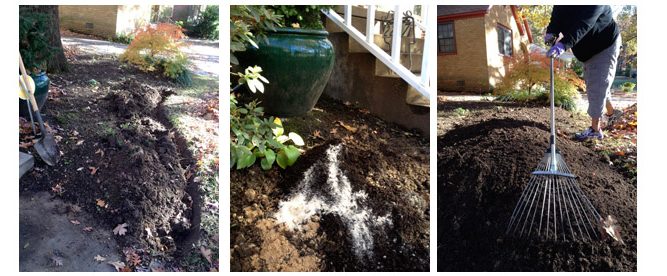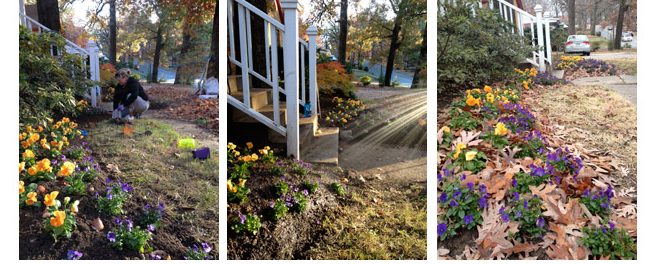How to Create the Most Stunning Seasonal Color Display in the Neighborhood!
Soil Preparation
First of all, the most overlooked aspect of a successful planting is soil preparation. Break up the soil in the planting area and mixed in Good Earth brand potting soil. This potting soil contains all kinds of goodies that topsoil or even organic compost do not such as sphagnum moss, perlite, Actino Root Protection, and pH balancers all of which provide the plant roots with an excellent environment for growth. We also added sand; it’s another great addition to your planting areas, as central Arkansas soils tend to be heavy and drain poorly. My soil happens to be very acidic so I added agricultural lime also. Adding these materials loosened the soil, created better air flow, and provided additional drainage.
Seasonal Color choices
Next, it was time to consider the plant materials themselves. Before you head to the store, do some research! Start by learning how much sun your areas get and at what time of day they get it. For best visual impact, plant a few larger areas of color as opposed to many small ones. Take into account the style of your home; more formal landscapes will look better with fewer plant varieties where as more casual landscapes can accommodate a larger variety of colors and textures. We used to suggest thumbing through magazines and books for ideas but now there is Pinterest, an online network that gives users the opportunity to find what they like and pin it to a specific board such as ‘Combination Planters’, one of The Good Earth’s most popular boards.
*The planting shown was installed in the fall. The orange flowers and pansies and the purple are violas. Violas have smaller flowers but the blooms tend to stand more upright than pansy blooms; however pansy blooms are larger. Panolas offer the best characteristics of both; bigger blooms and durability. Additional fall plant materials are ornamental cabbage, ornamental kale, Swiss chard and one of our favorites, ornamental mustard!
For spring color, the options are numerous! The Proven Winner series of annuals has been selected for hardiness and greatest visual impact. And it’s not all about the flowers! Coleus and other foliage plants offer vibrant colors. For instant color, consider planting hanging baskets. Depending on how your landscape is arranged, adding groupings of planters in your annual color areas, filling with a combination of plants, and surrounding them with a solid mass of low growing annual color can provide height and additional visual impact.
Feed Your Plants
Regardless of the actual plants you choose, do not forget this special ingredient when planting…Good Earth brand Jump Start! This product contains mycorrhizae, which can increase water and nutrient uptake by up to 1000 times! For this to be effective, add the granules into the root zone at planting. To get maximum blooms throughout the season, apply BR-61, a water soluble fertilizer that is the equivalent of steroids for your plants! Seriously, you will never use anything else once you start using BR-61. At planting, use Ferti-Lome Premium Bedding Plant Food for slow release fertilizer, which is helpful during cooler months when applying water soluble fertilizers such as BR-61 is easy to forget.
Mulch
Mulch provides good weed control, soil moisture retention and can keep plant roots insulated. Plus, it keeps landscape beds looking fresh!
Don’t forget!
Please note that this process shouldn’t be done once and then forgotten; amend the soil with every seasonal color change out. Add Good Earth brand Jump Start with every planting, including shrub, tree, perennial and annual plantings. Always have fertilizer on hand and don’t skip the mulch! Be aware during the process; for example, I noticed a ton of grubs in my soil, so I now know that treating the soil for grubs is going to be part of my maintenance routine. We hope this helps get you going and inspires you to create some amazing spaces!

